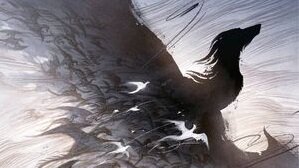Fiction Unbounders Lisa, Christie, and Amanda sat down to talk about the second book in Erika Johansen’s Queen of the Tearling trilogy, focusing on plot reveals, character development, biblical allusions, and what information Johansen is still holding back. Watch out for spoilers at the end (we’ll warn you when to stop reading if you haven’t finished the book yet).
So what did we think of Invasion of the Tearling, especially as compared to The Queen of the Tearling?
CH Lips: I like the strong female figures in these books: Kelsea, Aisa, Lily, and the Red Queen.
Lisa Mahoney: Definitely, but the Red Queen fell apart for a while here. I’d like to know, given what is revealed about her birth (which I won’t give away), how she took control of Mortmesne, but I guess that’s information Johansen doesn’t want us to know yet.
Amanda Baldeneaux: The author is still withholding a lot of information, but I feel a lot more satisfied after Invasion. She really asked a lot of her readers in Queen in terms of not telling us what was going on or how we got where we were. Here there was a lot of buildup to the main action between what happened where we left off and then building the backstory of Lily, and I wasn’t sure for many pages why we should care about Lily. I was going mad trying to puzzle it out and it slowed the first half of the book. I was like, let’s get to Kelsea!
CH Lips: Yeah, it was pretty frustrating. For a long time at the beginning Lily was sort of a doormat, before getting very fierce, but you knew we had to be spending a lot of time with Lily for a good reason.
Lisa Mahoney: She was like a foil to Kelsea. But at the same time Kelsea wasn’t doing that much in the first half of this book. In Queen she was on the move, actively trying to prove herself, going to war. Here she is trying to negotiate, to think carefully, which shows maturity.
Amanda Baldeneaux: Yeah, she was planning the siege, getting the people out of the distant lands and figuring out where to put them. I was struck by the choice to start out with a different character, Hall, as narrator. Again, I wanted to know when we would get to Kelsea.
Multiple Points of View
Lisa Mahoney: Okay, let’s talk about point of view. Some alternate points of view are consistent with those of Queen here, but the POV choice seems sometimes chosen as a convenient way to convey information to the reader that certain characters shouldn’t know. It really struck me when Aisa just happens to hide in the room where the Mace confronts Pen. Kelsea can’t know about it, but the author needs to inform us about the confrontation, so she uses Aisa’s POV. A convoluted choice, I think. But I think Aisa will be important to Book Three, and maybe she (as well as we) needs to know this background.
CH Lips: This was quite a page turner, which I liked, but I would have liked to explore some things in more depth, like Kelsea’s relationship with Pen. We don’t ever really see them interacting, except for the scene where they first make love, and even in that scene there’s not much dialogue before they get down to business. I would have liked to have more engagement in how their relationship was progressing.
Lisa Mahoney: I think part of that was point-of-view related. Kelsea doesn’t realize how much Pen loves her until the Mace tells her she’s blind about it.
CH Lips: In contrast to that, we went into such depth about Lily and her relationship with her husband.
Amanda Baldeneaux: Pen does have to be withholding though, part of the Queen’s guard rules, and Kelsea is still young and insecure. But now she’s becoming more knowledgeable, and so are we the readers as a result. In Queen we didn’t like not knowing what Kelsea did and didn’t know about the crossing.
Lisa Mahoney: Here we learn that Kelsea did know much more about the crossing than the author let us know in Queen, although we learn much more about it as Kelsea does. In Queen I felt like Kelsea was basing some of her actions upon knowledge about the crossing that was deliberately withheld from the reader, which doesn’t seem to follow standard point-of-view rules.
The Slave Market of Cairo.David Roberts' Egypt & Nubia, issued between 1845 and 1849 [Public domain], via Wikimedia Commons.
Themes
Amanda Baldeneaux: Did anyone find a theme? I didn’t really take time to look for one in this book because when a novel is a real page-turner, I just quit looking for literary elements and enjoy the ride.
Lisa Mahoney: To me the themes hit the full spectrum of political correctness: we have gays who are great, slaves which Kelsea frees regardless of consequences, the jailor Ewen who has developmental delays yet is accepted for his abilities, Jonathan who rescues Lily is black, and the well-educated white guy is the wife-beater. On the other hand, the ultimate heroic figure, William Tear, is a white British male.
Amanda Baldeneaux: We see a women’s rights agenda; social welfare both in 2046 and in the current storyline; evil gamblers buying children as fighters, an abuse Kelsea makes a top priority; and the corruption of organized religion.
Lisa Mahoney: Right, the religious leader who we read as “evil” has two women in his apartment who are drugged up.
Amanda Baldeneaux: And book burnings, like Fahrenheit 451.
CH Lips: The author Richard Bausch cautions against writing with a political agenda in mind, and it’s transparent here. We can see what issues Johansen is passionate about in these books.
Lisa Mahoney: With the fundamental issue in both timelines being the privileged rich versus the poor.
Agnolo Bronzino's Crossing of the Red Sea, circa 1540. Public domain via Wikimedia Commons. The painting is in the Palazzo Vecchio Museum.
CH Lips: Interestingly, one issue that’s not there is pacifism.
Amanda Baldeneaux: Yes, both Kelsea and Tear are capable of bloody violence. It was kind of hard to read at points, but I liked that Kelsea has the power to correct all these ills, like a philosopher king. These are the obstacles to a perfect world and why people will stand in the way, but she’s going to prevail. So it’s heavy-handed, but I liked living out the fantasy of better outcomes.
CH Lips: It didn’t detract from my enjoyment of the story!
Story Structure
Lisa Mahoney: What do we think about the story? Queen seemed like a hero’s journey in miniature, in which the unknown protagonist rises from obscurity, overcomes obstacles and tests with her new skills and objects of power, and achieves her destiny.
Amanda Baldeneaux: So is Invasion a continuation of that journey, as in many trilogies? Kelsea is “inside the belly of the beast” and “facing death” now in her progress through the hero’s journey. She finishes this book going into the Underworld (“Mortmesne,” Mort = death), and she is predicted to come back with new knowledge.
Lisa Mahoney: In Book Three she’ll return to her rule fully tested, with lots of cred, and mature enough to become the great ruler only she can be.
CH Lips: You wonder if her final test will be complicated by the fire creature, if she’ll have to contend with the big, immature mistake she made here in Invasion. How did he betray the Tear kings?
Biblical figures
CH Lips: Did you get the idea that William Tear is supposed to be a Moses-like figure, leading his people out of Egypt?
Lisa Mahoney: Right, unleashing evil elements upon the world as The Flood while he crosses with his carefully tested Chosen.
Amanda Baldeneaux: It’s a kind of Sodom and Gomorrah thing, too, where they leave the chaos behind.
CH Lips: I see Kelsea as the Christ figure. She’s willing to sacrifice herself to save her people (and the world).
Amanda Baldeneaux: Who’s the Red Queen then? Is she The Devil? If so, who or what is the fire creature, exactly? We get his name and a painting, but not much more to go on.
Hark! Here be Spoilers and Speculations on Book Three (and Game of Thrones)
CH Lips: Ya, what about the fire man, Rowland Finn? Do you understand what he did long ago?
Amanda Baldeneaux: No, but I’m worried that Kelsea didn’t make a very good trade with him.
Lisa Mahoney: But I like worrying because here we don’t know what Kelsea doesn’t know. I like her point to Finn: How can I grant forgiveness if I don’t even know what you’ve done?
Amanda Baldeneaux: Some questions we had from Queen were answered here. The Crossing did use a portal. I’d thought, no, it was an ocean, but Lisa, in our discussion of Queen you'd mentioned this theory, and you were right!
Lisa Mahoney: Yeah, I guess it’s a portal, but its opening was dependent on Tear’s magical jewels. I wonder if they went back in time, like thousands of years, because there’s no talk of ruins, and the flora and fauna of the world seems familiar. I picture them sailing off from Boston, going through the portal, and sailing down what is now the US East Coast.
Amanda Baldeneaux: If you look at the map, it’s kind of like Portugal. Does Spain have salt flats? Or maybe it’s the west coast, and the salt flats are Utah.
CH Lips: Spain was quite forested until they cut the trees down for building.
The man on fire in Invasion of the Tearling is Rowland Finn. Here we see Vidya, meaning True Knowledge, the personification of God. Shared at Wiki Commons for the progression of Humanity by Ne0Freedom. License: Kopimi.
Lisa Mahoney: Is the Fetch hundreds of years old? Is he her father? Why does everyone keep telling Kelsea she doesn’t want to know who her father is? What if The Fetch is William Tear, moving around in time as needed? They have the same skill set — slipping into places unseen and a capacity for violence when it serves their strong vision of justice. It would explain The Fetch’s detailed knowledge of hidden passages throughout the castle and the religious tower.
CH Lips: Okay, but then why won’t he tell her how he or Finn betrayed them? Why would it be so terrible if The Fetch were her father? Because she’s attracted to him? Remember you were wrong about Jon Snow, Lisa.
Lisa Mahoney: Oh, so wrong! (Sobs helplessly.)
Amanda Baldeneaux: He’s not dead. NOT DEAD. I picture Aisa as our little Arya Stark. Dark-haired hellcat with her little knife.
Lisa Mahoney: Jon is so dead.
Amanda Baldeneaux: Melisandre will resurrect him.
Lisa Mahoney: “Blood of kings.” Well, Rowland Finn is resurrected now, and we can’t wait to see what evil he wreaks in Book Three!





![Alice and that other Red Queen. Illustration by John Tenniel [Public domain], via Wikimedia Commons](https://images.squarespace-cdn.com/content/v1/5495fc96e4b0d669a5b4ba80/1435880562815-MFQ8GFH84M5EQ2YOMMMZ/image-asset.jpeg)
![The Slave Market of Cairo.David Roberts' Egypt & Nubia, issued between 1845 and 1849 [Public domain], via Wikimedia Commons.](https://images.squarespace-cdn.com/content/v1/5495fc96e4b0d669a5b4ba80/1435881503211-O1L1MRAYSMK2OO96VIR8/image-asset.jpeg)












Cadwell Turnbull's new novel — the first in a trilogy — imagines the hard, uncertain work of a fantastical justice.